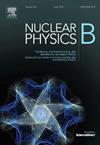Barrow entropy effects on thermodynamics and QPOs of a quintessence surrounded Frolov black hole model
IF 2.8
3区 物理与天体物理
Q2 PHYSICS, PARTICLES & FIELDS
引用次数: 0
Abstract
This research examines the dynamics and thermodynamics of a non-rotating Frolov black hole (BH) surrounded by a quintessence field, described by the parameters (charge), (Hubble length) and (quintessence coupling). In addition, the space-time structure, analyzed through the lapse function , reveals that increasing , , or radial distance enhances , while exerts a negligible influence on the horizon radii. The particle dynamics near the BH is governed by an effective potential , angular momentum , and a specific energy , which delineates stable and unstable orbits. The innermost stable circular orbits (ISCOs) contract with increasing and , but expand with , reflecting competing gravitational and quintessence-driven effects. Harmonic oscillations display unique radial, latitudinal, and orbital frequencies, which are redshift for observers at a distance, whereas periastron precession decreases for greater and . From a thermodynamic perspective, the BH shows positive mass and temperature throughout various parameter ranges, indicating global stability. Heat capacity anomalies and the swallowtail patterns of Gibbs free energy indicate phase transitions, with transitions from stable to unstable relying on , , and . Energy emission rates decrease as the parameters increase.
巴罗熵对典型包围Frolov黑洞模型热力学和QPOs的影响
本研究考察了被精质场包围的非旋转Frolov黑洞(BH)的动力学和热力学,精质场由参数Q(电荷)、α(哈勃长度)和β(精质耦合)描述。此外,通过延时函数h(r)分析时空结构,发现增加Q、α或径向距离r会增加h(r),而β对视界半径的影响可以忽略不计。黑洞附近的粒子动力学由有效势Veff、角动量L和比能量E控制,它们描述了稳定和不稳定的轨道。最内层稳定圆轨道(ISCOs)随Q和α的增加而收缩,但随β的增加而膨胀,反映了引力和精华驱动效应的竞争。谐波振荡显示出独特的径向、纬度和轨道频率,对于远处的观测者来说是红移的,而当Q和α较大时,近星进动会减小。从热力学的角度来看,黑洞在各个参数范围内均表现出正质量和正温度,表明黑洞具有全局稳定性。热容异常和吉布斯自由能的燕尾图表明相变,从稳定到不稳定的转变依赖于α, Q和β。能量发射率随参数的增大而减小。
本文章由计算机程序翻译,如有差异,请以英文原文为准。
求助全文
约1分钟内获得全文
求助全文
来源期刊

Nuclear Physics B
物理-物理:粒子与场物理
CiteScore
5.50
自引率
7.10%
发文量
302
审稿时长
1 months
期刊介绍:
Nuclear Physics B focuses on the domain of high energy physics, quantum field theory, statistical systems, and mathematical physics, and includes four main sections: high energy physics - phenomenology, high energy physics - theory, high energy physics - experiment, and quantum field theory, statistical systems, and mathematical physics. The emphasis is on original research papers (Frontiers Articles or Full Length Articles), but Review Articles are also welcome.
 求助内容:
求助内容: 应助结果提醒方式:
应助结果提醒方式:


